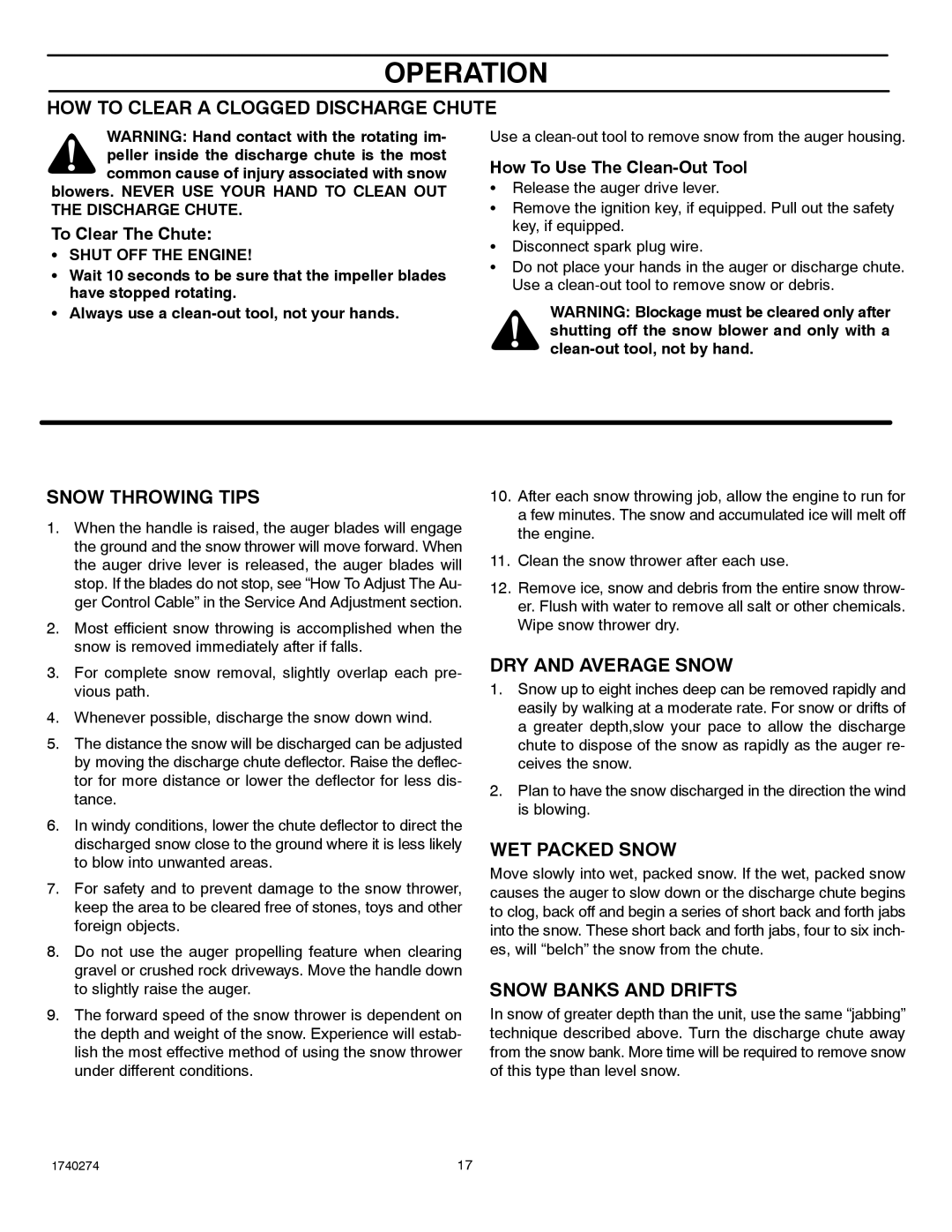
OPERATION
HOW TO CLEAR A CLOGGED DISCHARGE CHUTE
WARNING: Hand contact with the rotating im- peller inside the discharge chute is the most common cause of injury associated with snow blowers. NEVER USE YOUR HAND TO CLEAN OUT
THE DISCHARGE CHUTE.
To Clear The Chute:
SSHUT OFF THE ENGINE!
SWait 10 seconds to be sure that the impeller blades have stopped rotating.
SAlways use a
Use a
How To Use The Clean-Out Tool
SRelease the auger drive lever.
SRemove the ignition key, if equipped. Pull out the safety key, if equipped.
SDisconnect spark plug wire.
SDo not place your hands in the auger or discharge chute. Use a
WARNING: Blockage must be cleared only after shutting off the snow blower and only with a
SNOW THROWING TIPS
1.When the handle is raised, the auger blades will engage the ground and the snow thrower will move forward. When the auger drive lever is released, the auger blades will stop. If the blades do not stop, see “How To Adjust The Au- ger Control Cable” in the Service And Adjustment section.
2.Most efficient snow throwing is accomplished when the snow is removed immediately after if falls.
3.For complete snow removal, slightly overlap each pre- vious path.
4.Whenever possible, discharge the snow down wind.
5.The distance the snow will be discharged can be adjusted by moving the discharge chute deflector. Raise the deflec- tor for more distance or lower the deflector for less dis- tance.
6.In windy conditions, lower the chute deflector to direct the discharged snow close to the ground where it is less likely to blow into unwanted areas.
7.For safety and to prevent damage to the snow thrower, keep the area to be cleared free of stones, toys and other foreign objects.
8.Do not use the auger propelling feature when clearing gravel or crushed rock driveways. Move the handle down to slightly raise the auger.
9.The forward speed of the snow thrower is dependent on the depth and weight of the snow. Experience will estab- lish the most effective method of using the snow thrower under different conditions.
10.After each snow throwing job, allow the engine to run for a few minutes. The snow and accumulated ice will melt off the engine.
11.Clean the snow thrower after each use.
12.Remove ice, snow and debris from the entire snow throw- er. Flush with water to remove all salt or other chemicals. Wipe snow thrower dry.
DRY AND AVERAGE SNOW
1.Snow up to eight inches deep can be removed rapidly and easily by walking at a moderate rate. For snow or drifts of a greater depth,slow your pace to allow the discharge chute to dispose of the snow as rapidly as the auger re- ceives the snow.
2.Plan to have the snow discharged in the direction the wind is blowing.
WET PACKED SNOW
Move slowly into wet, packed snow. If the wet, packed snow causes the auger to slow down or the discharge chute begins to clog, back off and begin a series of short back and forth jabs into the snow. These short back and forth jabs, four to six inch- es, will “belch” the snow from the chute.
SNOW BANKS AND DRIFTS
In snow of greater depth than the unit, use the same “jabbing” technique described above. Turn the discharge chute away from the snow bank. More time will be required to remove snow of this type than level snow.
1740274 | 17 |
